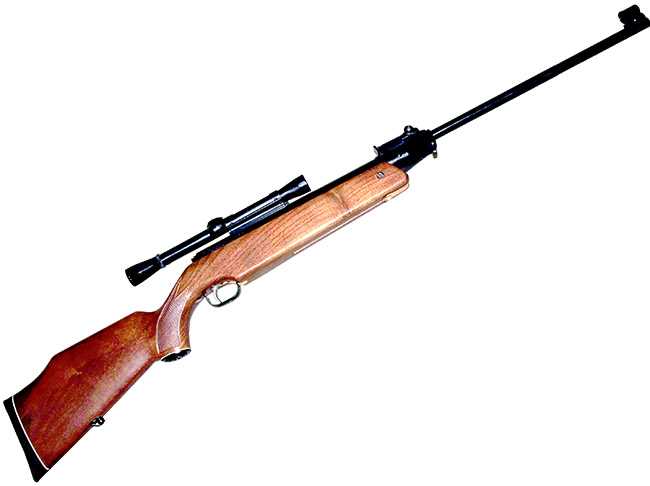
The FWB 124 I am overhauling.
This report covers:
- Beautiful shape
- Piston seal
- More piston to clea
- Breech seal and barrel
- Now for the real dirty work!
- Great technique
- The new and old mainspring
- New piston seal
- Summary
Today we are going to clean the parts and internal places of the FWB 124 that I brought back from the 2022 Texas airgun show several weeks ago. And this will be a different type of report because in this stage I normally describe how I cleaned the parts and then lubricated them and assembled them. There would even be a short test at the end to see that everything went back together as it should. But not today.
Because this 124 was the dirtiest air rifle I have ever seen, I decided to slow down the report and show you more detail for the cleaning. It took me hours to clean it.
Beautiful shape
Just because the rifle was filthy inside doesn’t mean that anything was wrong. The parts all came clean and were in fine shape once the piston seal residue was removed.
Piston seal
Remember that piston seal? It took me 45 minutes of hard work to clean it
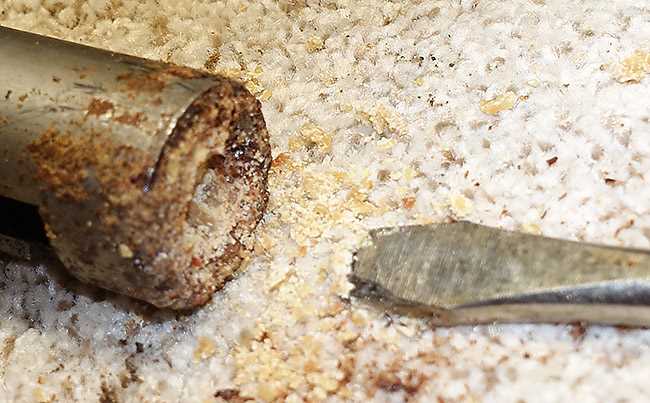
All the old piston seal that has dry-rotted into a hard waxy lump has to be scraped out and off. I scraped out a small depression in the old seal to show what has to be removed.
How do you clean a 124 piston? Well the piston head is has a deep depression in it that is formed to receive the base of the new seal, so all the old crud has to come out. I had recommendations to use solvent, and carburetor cleaner, but that’s messy and doesn’t get everything. Also, you have to be careful of the fumes from some carb cleaners.
I chose to dig out all the fragments of the seal with a flat-bladed screwdriver that you see in the picture above. That got about 80 percent of the seal but not all. I then used a dental pick to scrape out the rest. When I got close to the end I cleaned out the inside of the piston head depression. I used 0000 steel wool soaked in isopropyl alcohol.
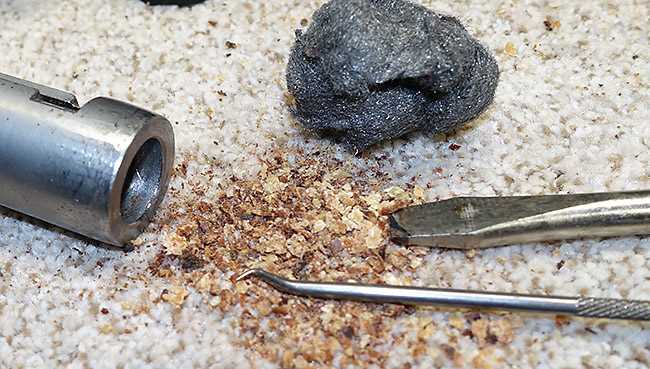
After cleaning the piston head, which took 45 minutes, the piston was ready to accept a new seal.
More piston to clean
I didn’t just clean the piston head, though that took the longest time. I also cleaned the outside and inside of the piston body and the piston rod in the center of the piston. That makes the metal ready for lubricant, though not everything will be lubricated.
Breech seal and barrel
When the rifle came to me there was a pellet stuck in the breech. I expected to find other pellets stuck inside the bore further up. The record number of pellets I have removed from a barrel is 14, and with that one there were a couple steel BBs in the stack. But with this rifle there was just a single pellet stuck in the breech. That’s good. It tells me the owner wasn’t a fool who kept loading pellets in hopes of shooting them out.
I rodded out the single pellet and found the bore was filthy as I expected. It was loaded with tiny particles of breech seal — what else? I expected the bore to be clean under that crud and it was. One patch was all it took to clean out all the stuff and then shiny metal.
The breech seal is in good condition but I removed it just to be sure. It is a little hard so I will replace it, even though it’s not absolutely necessary. However that lone pellet that popped out of the breech is NOT good. This rifle’s owner needs a fresh case of, “Learning about premium pellets” because sinker larvae and trick pellets, of which this is one, are not for a 124, any more than we would shoot darts in a 10-meter rifle or put kerosene into our car’s gas tank.
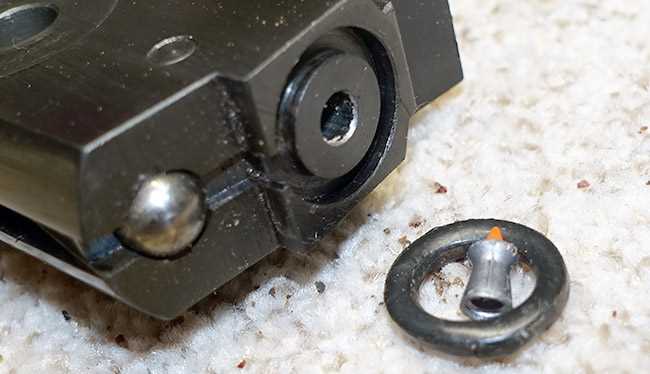
The breech seal looks okay but that pellet sure isn’t! BB’s gotta tell the rifle’s owner what pellets to shoot.
Now for the real dirty work!
By this time I had wiped off the breech seal particles from all the other rifle parts and they were everywhere. That, plus the condition of what I found inside the compression chamber tells me that SOMEBODY shot this rifle repeatedly, trying to get it to work! That is the very definition of crazy.
What awaited me inside the spring tube was a mass of breech seal material that was smashed into the end of the compression chamber — the deepest spot in the spring tube and the one that’s hardest to reach! Oh joy!
Once again I did not use solvent or carburetor cleaner for the same reasons I told you before. I used a long-bladed screwdriver to reach down to the end of the compression chamber and lever out the chunks of rotted seal material. Imagine brain surgery with the surgeon wearing boxing gloves.
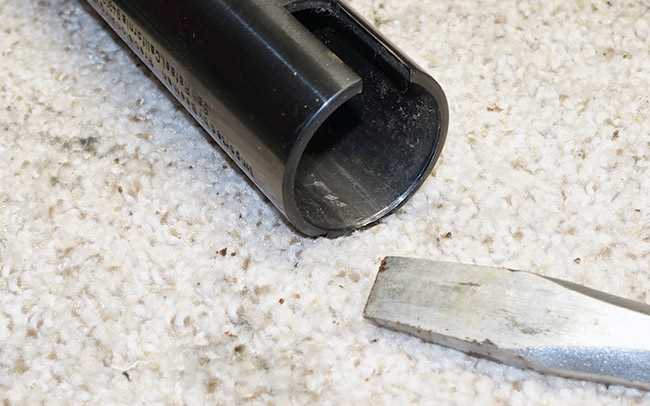
Time to dive in deep and start scraping.
This is why I tell you that if you want to work on spring-piston airguns you need to own long-bladed screwdrivers. Whenever I go into a pawn shop they are one of the things I always looks for.
After scraping out the compression chamber for about 45 minutes, I could see that only 10 percent of the seal material remained. It looked like it was going to be super stubborn to remove, so I borrowed a genuine dental pick from my neighbor, Denny, and taped it to the end of the long screwdriver. I used Gorilla tape because, with apologies to Red Green, duct tape just wouldn’t cut it. This is the first time I have ever done this, but it does work.

I taped the real dental pick on the end of the long-bladed screw driver with Gorilla tape.
I scraped for about ten minutes and did get about half of the remaining seal material out, but the pick just wasn’t going to get it all. So I taped a piece of 0000 steel wool on the end of a long half-inch wooden dowel and saturated it with isopropyl alcohol. Then I chucked the dowel in my electric drill and pushed it into the spring tube. After about a minute of turning that steel wool against the end of the compression chamber it was squeaky clean. This is another technique I have never tried before, and this, plus the dental pick trick, is the reason this entire report is about cleaning the 124 and nothing more. This is good stuff that I want to remember, no matter who else does!
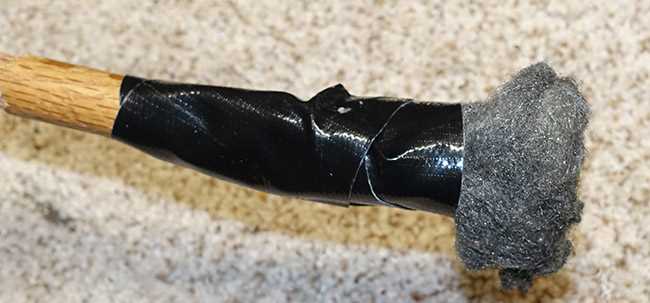
I taped the 0000 steel wool to the end of a half-inch dowel with Gorilla tape. Then I saturated the wool with isopropyl alcohol.
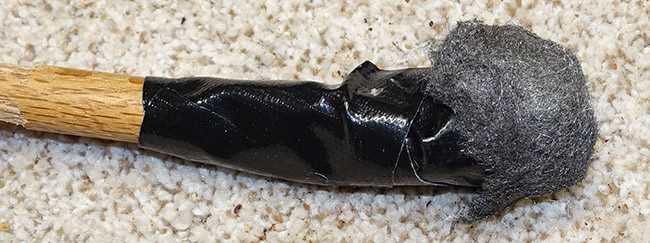
This is what the steel wool looked like after a minute of spinning inside the compression chamber of the FWB 124.
Great technique
I was surprised the steel wool held together and that it stayed taped to the dowel. I was also surprised that my cordless electric drill could chuck up a half-inch dowel and not loose it while spinning. This is a great technique for cleaning compression chambers in spring tubes! I just never had one this dirty that needed cleaning.
The new and old mainspring
At this point in the process I would clean the mainspring if I planned to use it again. But I made the decision not to. The new spring will replace it and there is nothing for BB to clean.

The old spring is on top. You can see that it is a little wobbly, compared to the new spring below. What you can’t see are the shiny spots worn on the coils in several places. Those are high friction points where vibration creeps in. You also can’t see that the old spring was improperly lubricated. It was very dry in spots.
New piston seal
I had a new piston seal on hand from the UK, but it was made of hard material and it also needed a lot of sizing to fit inside the spring tube. I opted to go with a new 124 piston seal from Pyramyd Air. I knew it was made from more pliable material and I was delighted to find that it will need very little sizing.
More pliable material means that a looser fit in the compression chamber will still work because this is a parachute seal whose end will expand to seal the air. What that means is hopefully higher velocity.
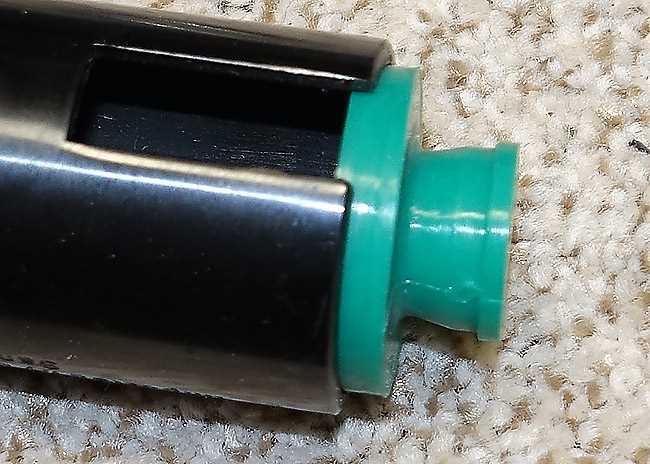
The piston seal from Pyramyd AIR is pliable and also sized to need very little fitting to the 124 spring tube. Note the bottom of the new seal. That shows you all the stuff I had to dig out of the piston head.
Summary
There was a lot in today’s report. It’s a reminder for myself and notes to follow for others who want to overhaul an FWB 121/124/125/127.


B.B.
Cool stuff! Now moly or synthetic?
-Y
Amalagard, TIAT or Red’n’Tacky.
Yogi,
Some of each, depending on where.
BB
BB
Not sure if one exists but do you ever consider replacing the spring(s) with a nitro piston?
Or is that considered a sacrilege with these or is it simply not compatible with the desired performance or power level?
Bob,
Sacrilege!! 😉
As far as I know, no gas spring has ever been fitted to a 124.
BB
BB,
LOL! Because of the piston rod and the trigger assembly, I do not think it can be done.
Bob M,
Sometimes a gas spring just will not work because of the way the sproinger operates. This sproinger has a rod with a notch on the end on the piston that runs through the middle of the spring and catches in the trigger assembly.
Sometimes a gas spring can be used when the trigger assembly is outside of the spring tube and catches the edge of the piston itself. A piece usually has to be machined to fit the rod of the gas spring into to keep it centered.
My personal experience and research have determined that gas springs are as likely to fail (leak) than metal springs. With proper lubrication, metal springs can last a lifetime. The old spring in this air rifle is still useable,
but since he has a new spring, why not replace it?
Most of the time a gas spring will have a faster “lock time”, but unless the air rifle itself has a considerable mass, the forward recoil can be painful. I have replaced the spring in a Gamo CFX with a gas spring. It had a very nasty habit of slapping me in the side of the head. I went back to the metal spring.
Do not believe all of the hype about gas springs. It has been proven that temperature does affect them also.
Having said all that, an airgun designed from the beginning to use a gas spring MAY function better with such. I am also sure that the technology has improved. I myself would actually like to have a Theoben gas spring air rifle. Weihrauch uses this technology in one of their air rifles. It is not cheap though.
The HW90 is the one with the gas spring. It is tunable, according to what I have researched. A couple reviewers stated the gas cylinder is set to 26 bar at the factory but the sweet spot seems to be around 18 bar. If you buy the pump and pressure gauge for tuning it will make for a fairly expensive investment.
FawltyManuel, where would one read about those nitro piston pressures please?
Found some discussion groups. Let me see if can locate them again then will post links.
Here is one FM remembers finding during research. Caveat: have never seen/held/owned/fired an HW90 so don’t know any more than what have learned from these sources. This one seemed particularly informative. Of course, if one knows nothing, anything seems informative!
https://www.airgunnation.com/threads/hw90-tuning-discoveries.1144871/
Thank you FawltyManuel for the link. I wonder whether, besides furthering my interest, it will serve to en- or disable… 🙂
RidgeRunner,
You must have felt the disturbance in the FORCE, Lol!
The DuskSide (Gas Springs) need a design of their own and not just to allow them to JUST REPLACE a coil spring straight across.
I have been thinking hard on a Gas Spring exclusive powerplant air rifle design. I think for starters it could eliminate the bi-directional recoil while maintaining the SUPERIOR LOCK Time.
Ed Schultz are you reading this?
The SIG ASP20s and other (few) successful Gas Spring powerplants such as the Weihrauch that FawltyManual pointed out, are obviously heavy and well enough designed to eliminate the cheek slap….awwww!
shootski
RidgeRunner
Thanks for clearing that up. The only airgun I ever got inside of was my first one the 1894 lever action and a gas piston would definitely not work in that one having an air transfer tube attached to the end of the piston.
The first nitro piston I got ‘Slapped’ some sense into me but I never figured it was the action of the piston alone but the overall design of the airgun. Apparently my guess was right because I “Turned the other cheek” sort of speaking and got another Gas Piston Airgun, The Valken Infiltrator. It is sort of a replica of the L96 Military Tactical Long Range Sniper Rifle. Only it is a much heavier powerful airgun and a pleasure to shoot as far as recoil goes. Along the same lines as the Black Ops Sniper rifle out now. But not identical.
Shootski is right about the weight.
What a good idea Tom Gaylord, to use a steel wool brush! 🙂
Cleaning with electric elbow grease, I imagine, would only work inside something like a tube to contain centrifugal escapees. Was there much vibration?
hi3,
There was some wobbling in the beginning but no vibration.
BB
BB,
Thanks for the ideas on cleaning the tube. I have used small metal drill brushes to clean the end of the tube before. I have a long bit extension. I have also used a small tube sanding bit (I do not know what you formally call it) to remove gouges and “scratch” the inside of compression tubes also.
Could you be referring to a two-stone hone? Used one to polish and smooth out the clutch master cylinder of my MGB 30+ years ago. Believe the steel wool worked better for cleaning out the crud in this rifle though.
Pro tip regarding the makeshift cleaning rod- Get a Hoppe’s Tornado bore brush (12 ga) and section of shotgun cleaning rod. Spins ever so smoothly with the drill. You can build up the diameter of the brush with steel wool. I cut off the pull loop at the bottom of the brush to work in blind holes. Good tough tools. I know a couple of my oldest Tornadoes are at least 30 years old and still work fine.
BB,
Quite the mess with that old seal breaking down.
A bit of trivia. It was me looking for information on replacing the piston seal in my FWB 124 that first brought me to your blog years ago and (for better or worse) I’ve been here ever since 🙂
Been wanting to replace the moly in the 124 with TIAT for a while now… think I left my round tuit in the garage. Thanks for the nudge, will get it out today.
Hank
Hank,
I’m so glad you found the blog! You have been a great contributor and friend over the years. 🙂
BB
That was a labor of love, B.B. The owner of this fine rifle is fortunate you took on the job. Hope never to let that horror happen to any of FM’s sproingers. If it does, let FM be expelled from Airgun World, his guns removed from custody.
RidgeRunner,
You must have felt the disturbance in the FORCE, Lol!
The DuskSide (Gas Springs) need a design of their own and not just to allow them to JUST REPLACE a coil spring straight across.
I have been thinking hard on a Gas Spring exclusive powerplant air rifle design. I think for starters it could eliminate the bi-directional recoil while maintaining the SUPERIOR LOCK Time.
Ed Schultz are you reading this?
The SIG ASP20s and other (few) successful Gas Spring powerplants such as the Weihrauch that FawltyManual pointed out, are obviously heavy and well enough designed to eliminate the cheek slap….awwww!
shootski
B.B.,
First, pardon the double post to RidgeRunner it must be the concussion from shooting the MAGNUM GAS Springs!
Having little experience with the spring piston powerplant airguns of any type I must ask you a newbie question or two!
What should the owner of this FWB 124 be expected to have noticed before the final indication of trouble with a pellet not leaving the breech and traveling to the target?
From your photographs it seems to me the crumbly pieces of the piston head should have been apparent for some time.
I would expect some significant performance degredation. Does the owner not have a Chronograph?
Would there have been a sound or other indication that could be felt by the trigger puller?
Are there more indications that this Newbie to Spring Piston guns just doesn’t know to ask?
shootski
shootski
Well here is one symptom, the piston will slam home quickly and violently and probably loudly without any air cushion being developed when the piston seal pressurizes the air in the cylinder.
I had the totally opposite problem with a newer Winchester version of the 1894 lever action airgun.
The air transfer tube attached to the piston head, it pushed a BB deeper into the inner barrel so air would not be diverted into the BB magazine feeding port hole in the barrel retainer / bb guide. Well the air passage was so narrow to restrict the power of the rifle that there was a noticeable hiss coming out of the barrel long after the BB was fired.
It never used all the compressed air it developed. Typical of a cost cut / lawyer modified 1894 “Spittin Image” airgun along with an obnoxious safety installed in the trigger housing.
Along with a fake wood print pattern on some sort of ‘compressed wood material ? stock”
Bob M,
Sorry to trigger a bad memory.
Good RANT though!
That is an unusual one in my book.
shootski
shootski
I hacksawed the receiver for hammer clearance, drilled out the stock to install a hammer spring, replaced the narrow air tube and a half dozen other parts with NOS 1894 parts and resealed it.
Now it works just like the original 60’s version. Even incorporated a toilet plumbing part to compensate for the butchered items that prevented me from installing the original hammer spring that went back into the stock area. Enjoyed the challenge.
Shootski,
The piston seal on my 124 went without any warning.
It had been shooting fine a couple of weeks earlier. The next time I took it out the first shot sounded weak and the second didn’t exit the barrel.
Hank
Vana2,
I was hoping to get B.B. to write a blog or even a series of blogs on what and how a newbie should look for as indication(s) of impending failure or potential damaging conditions that should get the newbie to stop shooting and seek help or at least advice.
Wow! That was a near instantaneous failure on your 124 Hank. So your only indication was no pellet hole somewhere down range…at least you didn’t stack pellets in the bore!
Kind of like when you rev the motor, pop the clutch and all that happens is LUNCH!
Followed by picking up all the pieces of the drivetrain.
shootski
B.B.,:
Look at these tools:
/blog/2019/08/special-tools-for-airgun-repairs/?swcfpc=1
and I found this: “How to tell
Disassembly is the most positive way to know if your gun has an original seal that’s gone bad or a new seal, but most new airgunners don’t want to do that. The good news is, it’s pretty easy to find out without disassembly — by examining the rifle closely and by shooting it. Look in the barrel for chunks of a yellow or brown material. If you see them, don’t shoot the gun any longer until the seal is replaced. If you notice the pellet start coming out slower (it will be very slow) the seal needs replacing. Stop shooting until it is replaced. If the gun vibrates hard or has a sharp jolt when shot — especially if it jumps forward a lot, the seal needs replacing. All spring piston rifles jump forward when they fire — this would be an exaggerated movement. If you are so new that you can’t tell if the forward recoil is excessive, better stop and have someone who knows airguns examine the rifle.”
In: /blog/2017/10/basic-airgun-maintenance-for-beginners/?swcfpc=1
Which are good but short and pretty specific.
shootski
Hello all,
I have some older classics that are shooting fine right now (chronograph). Since I cannot reseal most of them, I ponder what to do when the airguns stop working. Most where passed on to me and do not know the history of them quite well.
Love the cleaning tips.
Question for you all.
If the topic has been covered, please point me to the articles.
At times, I look around the usual websites for interesting things ( garage sells, flea markets.) Sometimes, I come across some vintage pellets. I want to stock up because one never knows what the future will bring. Imagine a one dollar per pellet in the next ten years. Looking at some of the retail and online stores, JSB, RWS and H&N pellets go for over $20 a can. How good are vintage or older pellets compared to today’s? I am thinking of JSBs in the white cans with red letters, Beeman’s and so on. If the older pellets could be bought at a fraction of today’s prices, are they worth it? Thinking of fit and accuracy in Diana, WH, FW……airguns.
Alex2no on buying cheap pellets: I would only stock up on those that I would actually use. 🙂
For me, that would mean wadcutter pellets for shorter distances and paper targets, and roundheads for shooting over longer distances.
And, most importantly, I would only (!) buy those that I know to work best in my airguns. Have you tested which pellet is best suited to which airgun yet?
Finally, if I were to store them for a long period, ie years, then I would think about ways of excluding air. Vacuum sealer? 🙂
One pellet FM has not yet tested in the air rifles is the vintage Crosman ash can shaped ones. Still have a partial tin of .22s which came with the Crosman 38T handed down. Will try them out next shooting session; curious to see how these will perform in the rifles.
Please FawltyManuel, what is an “…ash can shape…”?
I seem to remember Tom Gaylord (B.B. Pelletier) mentioning that today’s pellets are of higher quality than they used to be. So, I would expect lesser results, even in a target revolver.
Have you experimented with rotating the barrel in your Crosman T38 ?
FawltyManuel October 12, 2022 at 2:01 pm
They are the barrel-like ones to the left side of the picture; have about 200 of them still. They do well enough in the 38T; want to try them in the springer and the PCP just for fun. Not expecting much accuracy from these oldies. Not expecting much accuracy from THIS oldie.
Had the 38T rebuilt by Precision Pellet; don’t know if they rotated the barrel but as the revolver is shooting well enough think it is wise to leave it alone for now.
Thanks FawltyManuel. Those pellets remind me of the metal rubbish bins with vertical strength lines/creases.
Mine is not used for hot ashes but as a rat proof and temporary rubbish storage (I dispose of the bin bags in the communal skips on my way out of the hamlet I live in).
Anyway, those pellets would be fun to shoot because, well, I would expect rather random results. 🙂
hihihi,
Although it sounds like a great idea to store pellets in a vacuum you would be better off purging the container with Nitrogen gas since it is the Oxygen in air that is the problem.
You could also drop some Oxygen absorbers in the container just the same as for some long term food storage. You can open the container easily and since the absorbers will remove the small amounts of Oxygen that gets in you will not need to worry about your pellets corroding ever!
shootski
Thank you shootski !
I had to look up what an oxygen absorber is and was surprised that they’re simply salt and iron powder filled sachets (iron rusts thereby uses up oxygen). Brilliant idea! 🙂
Alex2no, personally, I would not stock up on old pellets. Here is why: I found a case of 12 plastic boxes of old Crosman copperhead pellets and some partials in my Dad’s basement last year. These were about 35 to 40 years old and were left over from my pre-teen years before I got my first hunting license at age 12. They are now covered with a white powdery substance; some of them have what appears to be a white crystalline coating and have corroded. I don’t really know enough about chemistry to hazard a guess as to what that is, because I don’t want to trigger a debate about lead oxide with Shootski, but whatever it is, I don’t want to be breathing that or sandblasting my airgun barrels with it (most of my shooting is in my basement) for now. 1) I have young kids breathing the same air and 2) despite my handle, I don’t want to go the way of the Romans. ;o)
I tried “cleaning” a few of those pellets, but my methods didn’t work and left me with a jar of liquid that I now don’t know how to properly dispose of.
Having said all that, I don’t know if the damp, farmhouse basement, the oak bureau they were stored in, the passage of 30-40 years, or all of the above had anything to do with their condition, but even if someone else’s milage might vary, I would not buy old pellets to store them long term. I would get new(ish) pellets and then stock up when a sale or other opportunity presents itself and then rotate them in my shooting (perhaps after a test to see if a new lot didn’t perform up to expectations) . I would only do this in larger quantities for pellets that are known to shoot well in the guns I shoot. But I would probably not store more than 5 years’ worth of what I would use.
As for vacuum sealing, that might slow down the processes at work, but there is still a fair amount of air in the tins and unless there was a way to nitrogen purge the air in a closed and taped tin, I don’t think it would work, but on that I defer to others with more experience and knowledge of such things. Good luck!
Alex2no,
There are vintage pellet tin (container) collectors. You might be able to make more money selling the top tins and buying way more modern top rated pellets!
Having experience with pellets for most of my life (coming up on 74 years) modern pellets, that work in your airgun, are worth even the higher prices that are being charged for them these days.
shootski
The FWB124 is calling my name…
BB my gosh! 🙂 You know what will happen if I start to look for it 🙂 This conversation with my wife… why… why…. You are not going to generate the next blog part, do you? 🙂 🙂 🙂 (please do)
tomek,
Better put your earplugs in because on Monday that 124 is going to knock you down and holler in your ear! 🙂
BB
BB,
I knew it… I have plenty of earplugs prepared 🙂